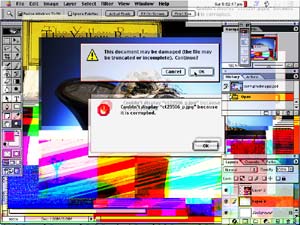
|
1: ct64453_p.jpg:
ADAM AND EVE COLUMN 1600 - 1620: Museum no. W.25-1959
The
oldest & most recent selections were made from the online database
'Object Type' category as follows: Architecture fittings (woodwork)
/ Silver & other Metals / Textiles & furnishings (household
objects) / Ceramics & glass (flasks bottle & jugs) / Miscellaneous
(tools & equipment).
The selected objects were emailed from the V&A online database for 3D modelling and inclusion in the 'Artefact' 3D engine. Serendipity dictated that all the images were corrupted in transmission and arrived in a dismembered state. Each image had become fused with other emailed images and the computers graphical interface. The 'genetic' information derived from these selected images can be seen mutating within the 'Artefact' Project.
Each of these
objects is modelled and incorporated into the Artefact generative
system. As online users interact with the objects generated by the
Artefact system the 'genetic' information is transmitted to the
Artefact located in Gallery 70 at the V&A.
The following images were generated as part of the Artefact development process.
|




